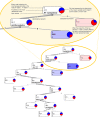Clinical factors associated with statins prescription in acute ischemic stroke patients: findings from the Lombardia Stroke Registry
- PMID: 24650199
- PMCID: PMC3994484
- DOI: 10.1186/1471-2377-14-53
Clinical factors associated with statins prescription in acute ischemic stroke patients: findings from the Lombardia Stroke Registry
Abstract
Background: Statins, due to their well-established pleiotropic effects, have noteworthy benefits in stroke prevention. Despite this, a significant proportion of high-risk patients still do not receive the recommended therapeutic regimens, and many others discontinue treatment after being started on them. The causes of non-adherence to current guidelines are multifactorial, and depend on both physicians and patients. The aim of this study is to identify the factors influencing statin prescription at Stroke Unit (SU) discharge.
Methods: This study included 12,750 patients enrolled on the web-based Lombardia Stroke Registry (LRS) from July 2009 to April 2012 and discharged alive, with a diagnosis of ischemic stroke or transient ischemic attack (TIA) and without contra-indication to statin therapy. By logistic regression analysis and classification trees, we evaluated the impact of demographic data, risk factors, tPA treatment, in-hospital procedures and complications on statin prescription rate at discharge.
Results: We observed a slight increase in statins prescription during the study period (from 39.1 to 43.9%). Lower age, lower stroke severity and prestroke disability, the presence of atherothrombotic/lacunar risk factors, a diagnosis of non-cardioembolic stroke, tPA treatment, the absence of in-hospital complications, with the sole exception of hypertensive fits and hyperglycemia, were the patient-related predictors of adherence to guidelines by physicians. Overall, dyslipidemia appears as the leading factor, while TOAST classification does not reach statistical significance.
Conclusions: In our region, Lombardia, adherence to guidelines in statin prescription at Stroke Unit discharge is very different from international goals. The presence of dyslipidemia remains the main factor influencing statin prescription, while the presence of well-defined atherosclerotic etiopathogenesis of stroke does not enhance statin prescription. Some uncertainties about the risk/benefit of statin therapy in stroke etiology subtypes (cardioembolism, other or undetermined causes) may partially justify the underuse of statin in ischemic stroke. The differences that exist between current international guidelines may prevent a more widespread use of statin and should be clarified in a consensus.
Figures



References
-
- Calabrò P, Yeh ET. The pleiotropic effects of statins. Curr Opin Cardiol. 2005;20(6):541–6. doi: 10.1097/01.hco.0000181482.99067.bf. - DOI - PubMed
-
- Amarenco P, Bogousslavsky J, Callahan A 3rd, Goldstein LB, Hennerici M, Rudolph AE, Sillesen H, Simunovic L, Szarek M, Welch KM, Zivin JA. Stroke Prevention by Aggressive Reduction in Cholesterol Levels (SPARCL) Investigators. High-dose atorvastatin after stroke or transient ischemic attack. N Engl J Med. 2006;355(6):549–59. - PubMed
MeSH terms
Substances
LinkOut - more resources
Full Text Sources
Other Literature Sources
Medical
Miscellaneous

